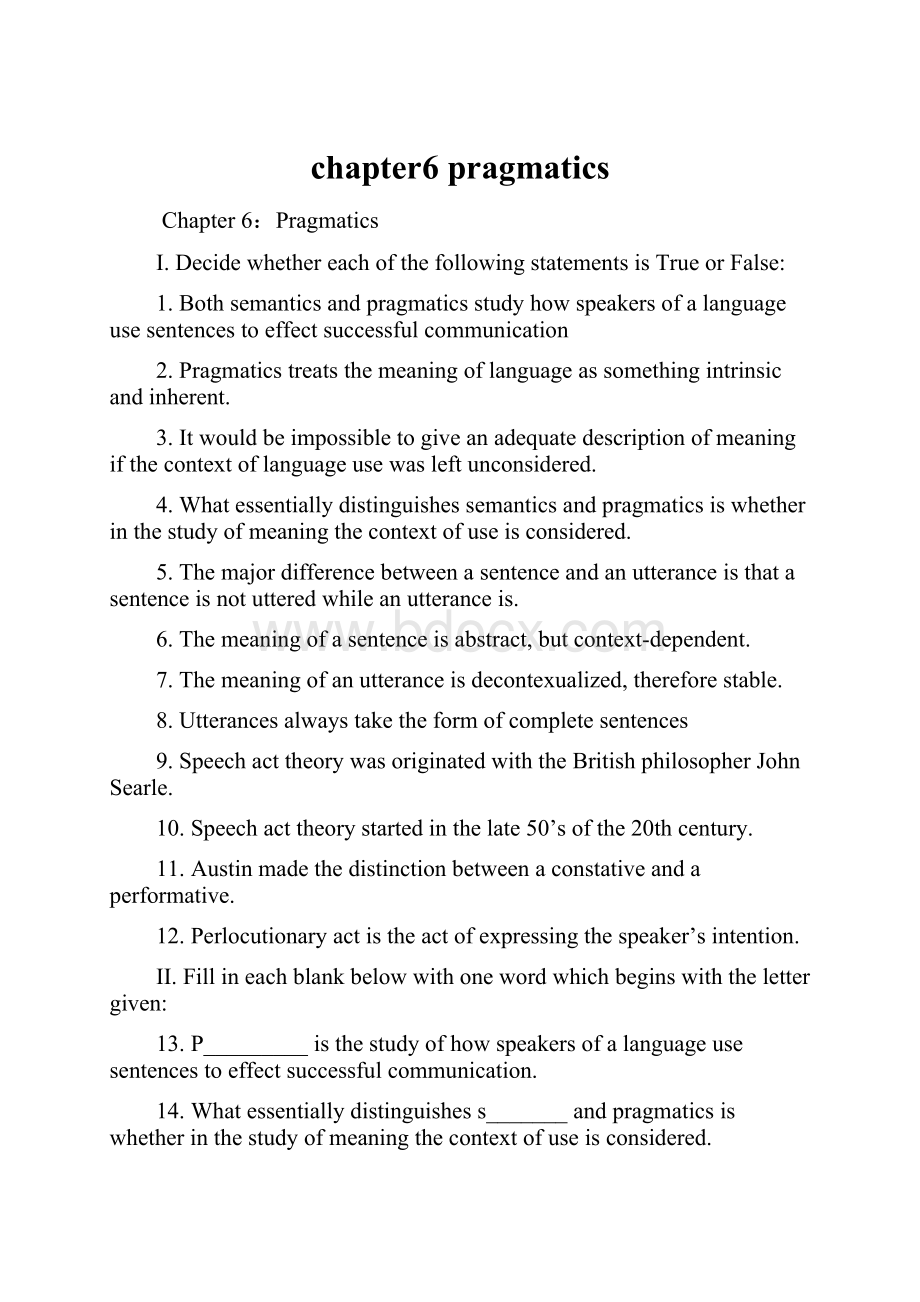chapter6 pragmatics.docx
《chapter6 pragmatics.docx》由会员分享,可在线阅读,更多相关《chapter6 pragmatics.docx(11页珍藏版)》请在冰豆网上搜索。

chapter6pragmatics
Chapter6:
Pragmatics
I.DecidewhethereachofthefollowingstatementsisTrueorFalse:
1.Bothsemanticsandpragmaticsstudyhowspeakersofalanguageusesentencestoeffectsuccessfulcommunication
2.Pragmaticstreatsthemeaningoflanguageassomethingintrinsicandinherent.
3.Itwouldbeimpossibletogiveanadequatedescriptionofmeaningifthecontextoflanguageusewasleftunconsidered.
4.Whatessentiallydistinguishessemanticsandpragmaticsiswhetherinthestudyofmeaningthecontextofuseisconsidered.
5.Themajordifferencebetweenasentenceandanutteranceisthatasentenceisnotutteredwhileanutteranceis.
6.Themeaningofasentenceisabstract,butcontext-dependent.
7.Themeaningofanutteranceisdecontexualized,thereforestable.
8.Utterancesalwaystaketheformofcompletesentences
9.SpeechacttheorywasoriginatedwiththeBritishphilosopherJohnSearle.
10.Speechacttheorystartedinthelate50’softhe20thcentury.
11.Austinmadethedistinctionbetweenaconstativeandaperformative.
12.Perlocutionaryactistheactofexpressingthespeaker’sintention.
II.Fillineachblankbelowwithonewordwhichbeginswiththelettergiven:
13.P_________isthestudyofhowspeakersofalanguageusesentencestoeffectsuccessfulcommunication.
14.Whatessentiallydistinguishess_______andpragmaticsiswhetherinthestudyofmeaningthecontextofuseisconsidered.
15.Thenotionofc_________isessentialtothepragmaticstudyoflanguage.
16.Ifwethinkofasentenceaswhatpeopleactuallyutterinthecourseofcommunication,itbecomesanu___________.
17.Themeaningofasentenceisa_______,anddecontextualized.
18.C________werestatementsthateitherstateordescribe,andwerethusverifiable.
19.P________weresentencesthatdidnotstateafactordescribeastate,andwerenotverifiable.
20.Al_________actistheactofutteringwords,phrases,clauses.Itistheactofconveyingliteralmeaningbymeansofsyntax,lexiconandphonology.
21.Ani__________actistheactofexpressingthespeaker’sintention;itistheactperformedinsayingsomething.
22.Ac_________iscommitthespeakerhimselftosomefuturecourseofaction.
23.Ane________istoexpressfeelingsorattitudetowardsanexistingstate.
24.Therearefourmaximsunderthecooperativeprinciple:
themaximofq_______,themaximofquality,themaximofrelationandthemaximofmanner.
III.Therearefourchoicesfollowingeachstatement.Markthechoicethatcanbestcompletethestatement:
25._________doesnotstudymeaninginisolation,butincontext.
A.Pragmatics B.Semantics
C.Senserelation D.Concept
26.Themeaningoflanguagewasconsideredassomething_______intraditionalsemantics.
A.contextual B.behaviouristic
C.intrinsic D.logical
27.Whatessentiallydistinguishessemanticsandpragmaticsiswhetherinthestudyofmeaning_________isconsidered.
A.reference B.speechact
C.practicalusage D.context
28.Asentenceisa_________concept,andthemeaningofasentenceisoftenstudiedinisolation.
A.pragmatic B.grammatical
C.mental D.conceptual
29.Ifwethinkofasentenceaswhatpeopleactuallyutterinthecourseofcommunication,itbecomesa(n)_________.
A.constative B.directive
C.utterance D.expressive
30.Whichofthefollowingistrue?
A.Utterancesusuallydonottaketheformofsentences.
B.Someutterancescannotberestoredtocompletesentences.
C.Noutterancescantaketheformofsentences.
D.Allutterancescanberestoredtocompletesentences.
31.Speechacttheorydidnotcomeintobeinguntil__________.
A.inthelate50’softhe20thecentury
B.intheearly1950’s
C.inthelate1960’s
D.intheearly21stcentury.
32.__________istheactperformedbyorresultingfromsayingsomething;itistheconsequenceof,orthechangebroughtaboutbytheutterance.
A.Alocutionaryact B.Anillocutionaryact
C.Aperlocutionaryact D.Aperformativeact
33.AccordingtoSearle,theillocutionarypointoftherepresentativeis______.
A.togetthehearertodosomething
B.tocommitthespeakertosomething’sbeingthecase
C.tocommitthespeakertosomefuturecourseofaction
D.toexpressthefeelingsorattitudetowardsanexistingstateofaffairs.
34.Alltheactsthatbelongtothesamecategorysharethesamepurpose,buttheydiffer__________.
A.intheirillocutionaryacts B.intheirintentionsexpressed
C.intheirstrengthorforce D.intheireffectbroughtabout
35.__________isadvancedbyPaulGrice
A.CooperativePrinciple B.PolitenessPrinciple
C.TheGeneralPrincipleofUniversalGrammar D.AdjacencyPrinciple
36.Whenanyofthemaximsunderthecooperativeprincipleisflouted,_______mightarise.
A.impoliteness B.contradictions
C.mutualunderstanding D.conversationalimplicatures
IV.Definethetermsbelow:
37.pragmatics 38.context 39.utterancemeaning
40.sentencemeaning 41.constative 42.performative
43.locutionaryact 44.illocutionaryact
45.perlocutionaryact 46.CooperativePrinciple
V.Answerthefollowingquestionsascomprehensivelyaspossible.Giveexamplesforillustrationifnecessary:
47.Howaresemanticsandpragmaticsdifferentfromeachother?
48.Howdoesasentencedifferfromanutterance?
49.Howdoesasentencemeaningdifferfromanutterancemeaning?
50.Discussindetailthelocutionaryact,illocutionaryactandperlocutionaryact.
51.Searleclassifiedillocutionaryactintofivecategories.Discusseachofthemindetailwithexamples.
52.Whatarethefourmaximsunderthecooperativeprinciple?
53.Howdoesthefloutingofthemaximsgiverisetoconversationalimplicatures?
54.WhichoftheConversationalMaximsisbeigviolatedinthefollowingconversation.
A:
Isheagoodteacher?
B:
Heisaveryhandsomebachelor.
55.Whatarethesamenessandthedifferencebetweenthefollowingfiveutterances?
(1)WillJohnleavetheroom?
(2)Johnwillleavetheroom.
(3)John,leavetheroom.(4)WouldthatJohnlefttheroom?
(5)IfJohnleavestheroom,Iwillleavealso.
Chapter6Pragmatics
I.DecidewhethereachofthefollowingstatementsisTrueorFalse:
l.F 2.F 3.T 4.T 5.F 6.F 7.F 8.F 9.F 10.T 11.T 12.F
II.Fillineachblankbelowwithonewordwhichbeginswiththelettergiven:
13.Pragmatics 14.semantics 15.context 16.utterance 17.abstract
18.Constatives 19.Performatives 20.locutionary 21.illocutionary
22.commissive 23.expressive 24.quantity
III.Therearefourchoicesfollowingeachstatement.Markthechoicethatcanbestcompletethestatement:
25.A 26.C 27.D 28.B 29.C 30.B
31.A 32.C 33.B 34.C 35.A 36.D
IV.Definethetermsbelow:
37.pragmatics:
Pragmaticscanbedefinedasthestudyofhowspeakersofalanguageusesentencestoeffectsuccessfulcommunication.
38.Context:
Generallyspeaking,itconsistsoftheknowledgethatissharedbythespeak-erandthehearer.Thesharedknowledgeisoftwotypes:
theknowledgeofthelanguagetheyuse,andtheknowledgeabouttheworld,includingthegeneralknowledgeabouttheworldandthespecificknowledgeaboutthesitu-ationinwhichlinguisticcommunicationistakingplace.
39.utterancemeaning:
themeaningofanutteranceisconcrete,andcontext-dependent.Utteranceisbasedonsentencemeaning;itisrealizationoftheabstractmeaningofasentenceinarealsituationofcommunication,orsimplyinacontext.
40.sentencemeaning:
Themeaningofasentenceisof-tenconsideredastheabstract,intrinsicpropertyofthesentenceitselfintermsofapredication.
41.Constative:
Constativeswerestatementsthateitherstateordescribe,andwereverifi-able;
42.Performative:
performatives,ontheotherhand,weresentencesthatdidnotstateafactordescribeastate,andwerenotverifiable.Theirfunctionistoperformaparticularspeechact.
43.locutionaryact:
Alocutionaryactistheactofutteringwords,phrases,clauses.Itistheactofconveyingliteralmeaningbymeansofsyntax,lexiconandphonol-ogy.
44.illocutionaryact:
Anillocutionaryactistheactofexpressingthespeaker'sintention;itistheactperformedinsayingsomething.
45.perlocutionaryact:
Aperlocutionaryactistheactper-formedbyorresultingfromsayingsomething;itistheconsequenceof,orthechangebroughtaboutbytheutterance;itistheactperformedbysayingsomething.
46.CooperativePrinciple:
ItisprincipleadvancedbyPaulGrice.Itisaprinciplethatguidesourconversationalbehaviours.Thecontentis:
Makeyourconversationalcontributionsuchasisrequiredatthestageatwhichitoccursbytheacceptedpurposeorthetalkexchangeinwhichyouareengaged.
V.Answerthefollowingquestionsascomprehensivelyaspossible.Giveexamplesforillustrationifnecessary:
47.Howaresemanticsandpragmaticsdifferentfromeachother?
Traditionalsemanticsstudiedmeaning,butthemeaningoflanguagewasconsideredassomethingintrinsic,andinherent,i.e.apropertyattachedtolanguageitself.Therefore,meaningsofwords,meaningsofsentenceswereallstudiedinanisolatedmanner,detachedfromthecontextinwhichtheywereused.Pragmaticsstudiesmeaningnotinisolation,butincontext.Theessentialdistinctionbetweens